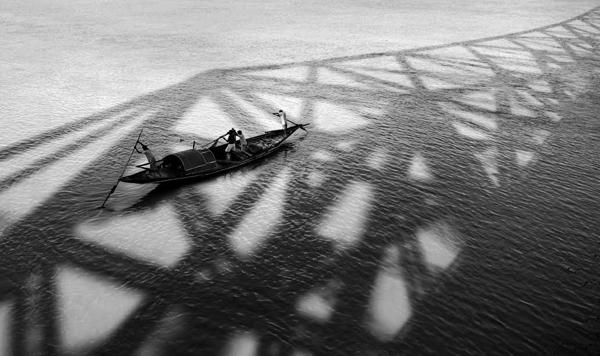 image
image
Howrah Bridge: A visual journey through the lens
Despite the grandeur of Victoria Memorial and many later day installations, the most enduring symbol of Kolkata is perhaps the wonder that is Howrah Bridge, an overpass that is recognised globally to identify the City of Joy and has been celebrated in movies from the black and white era to the modern day Bollywood flicks that do not let go any opportunity to capture the marvel in celluloid canvas.
.jpg)
This year, well known photographer Bijoy Chowdhury made it a subject of his annual calendar everyone waits for. The series of 12 black and white images in the calendar captures Howrah Bridge and life around it, in its many splendor.
.jpg)
From the innocent frame of a foreign visitor taking a selfie with a tea seller in one of the ghats in the backdrop of the bridge to a solitary boat floating in the Hooghly waters under the mellow afternoon shadow of the imposing cantilevers of the bridge, Chowdhury captures the impact of the bridge on life and its seamless beauty in daily activities.
.jpg)
So in another image it is just the impression of the bridge seen through the filter of a piece of cloth being dried by one of the bathers in the ghats.
.jpg)
Howrah Bridge is a lensman's favourite subject, needless to say, owing to its design. The bridge does not have nuts and bolts and was built by riveting the whole structure. It consumed 26,500 tons of steel, out of which 23,000 tons of high-tensile alloy steel, known as Tiscrom, were supplied by Tata Steel.
.jpg)
.jpg)
The bridge was designed in the British era by James Meadows Rendel. Across the river Hooghly, its illustrious presence itself has weaved a daily life.
.jpg)
.jpg)
During Chuwdhury's long photography centered around this city, he had always felt an urge to be associated with the public life stretched around this bridge.
.jpg) "Inspired by this cause, it's my humble attempt to capture this architechtural wonder along with the surroundings that have built around this," Chowdhury says.
"Inspired by this cause, it's my humble attempt to capture this architechtural wonder along with the surroundings that have built around this," Chowdhury says. Top Headlines
-
Lifestyle
ACM India unveils National AI Olympiad 2026 to spot school talent for global AI stage
December 21, 2025
-
Lifestyle
'Dont join politics': Why Tharoor defied his mother and endorsed his conviction
December 15, 2025
-
Lifestyle
Birbhum: Sitaramdas Omkarnath Chair at Biswa Bangla Biswavidyalay
December 04, 2025
-
Lifestyle
Rediscovering Arunachal's Monpa Cuisine: One Womans Millet Momo Revolution
November 24, 2025
-
Lifestyle
Shiny things by Jinia: A luxury evolution by visionary entrepreneur, healer
November 19, 2025
-
Lifestyle
Mystique and Memories: Wiccan Brigade hosts its first Halloween Fest in Kolkata
November 17, 2025
-
Lifestyle
Rotary Club of Calcutta Samaritans hosts three-day youth leadership awards program for tribal students in Bakura
November 15, 2025
-
Lifestyle
Rotary Club, South Kolkata Vision inaugurate newly developed children's park in Sonarpur
November 15, 2025
-
Lifestyle
Bengali couple promoting Indian music and culture among young Americans
October 28, 2025
-
Lifestyle
Durga Puja sustainability: One of the oldest awards goes flex-free
October 17, 2025
